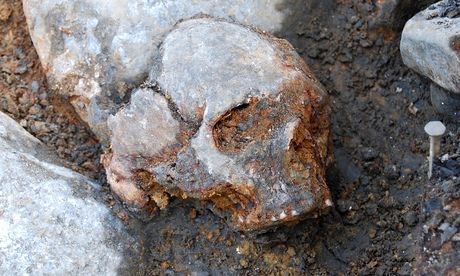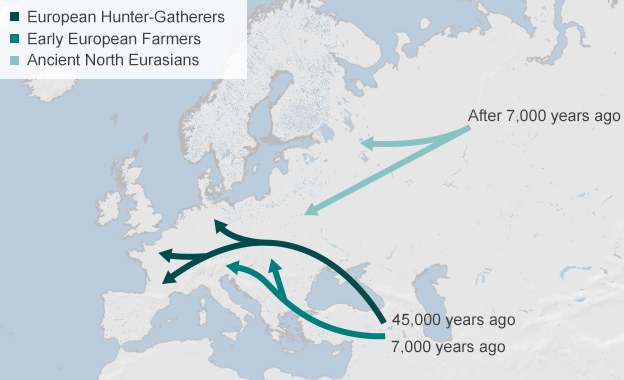7000 year old German farmer helps uncover genetic history of Europeans
Researchers Prof Alan Cooper and Dr Wolfgang Haak from the Australian Centre for Ancient DNA along with an international team of experts have sequenced the genomes of a ~7,000-year-old farmer from Germany and eight ~8,000-year-old hunter-gatherers from Luxembourg and Sweden. The findings have been published in Nature today.
[caption id="attachment_7139" align="alignnone" width="460" caption="The cranium of a female hunter-gatherer found in Kanaljorden, Sweden. Research suggests all modern Europeans have hunter-gatherer and early farmer DNA. Photograph: Fredrik Hallgren, The Guardian"] [/caption]
[/caption]
Upon analysis of the genomes, researchers found that most present-day Europeans derive from at least three highly ancient populations:
[caption id="attachment_7135" align="alignnone" width="624" caption="Image: BBC News"] [/caption]
[/caption]
This study builds on previous work published in Nature Communications and Science last year.
"Recent genetic studies we did at the University of Adelaide on ancient hunter-gatherers and early farmer remains suggested a massive expansion of people into Europe coinciding with the spread of farming," says Dr Wolfgang Haak.
"However, the relative proportions and distributions of the genetic components contributing to modern Europeans remained unclear. This study has added significantly to our knowledge of the genetic make-up of our European ancestors."
They compared the ancient humans to present-day people, looking at the genetics of about 2,400 individuals from almost 200 diverse worldwide contemporary populations.
"The surprising finding was that present-day Europeans trace their ancestry back to three and not just two ancestral groups as previously thought," says ACAD Director and Australian Laureate Fellow Professor Alan Cooper who, together with Dr Haak, is co-author on the study.
The third ancestral group is a mysterious population that spanned North Eurasia and genetically connects Europeans and Native Americans.
"It seems clear now that the third group linking Europeans and Native Americans arrived in Central Europe after the early farmers," explains one of the lead investigators, Professor Johannes Krause from the University of Tübingen and director of the Max Planck Institute for History and Sciences in Jena, Germany. "We are however not sure yet when the Northern Eurasian component entered central Europe."
Contrary to some previous reconstructions that show Mesolithic people with fair skin, and farmers depicted with dark skin, these findings show the opposite.
"It really does look like the indigenous West European hunter gatherers had this striking combination of dark skin and blue eyes that doesn't exist any more," Prof Reich told BBC News.
"There's an evolutionary argument about this - that light skin in Europe is biologically advantageous for people who farm, because you need to make vitamin D," David Reich told BBC News.
"Hunters and gatherers get vitamin D through their food - because animals have a lot of it. But once you're farming, you don't get a lot of it, and once you switch to agriculture, there's strong natural selection to lighten your skin so that when it's hit by sunlight you can synthesise vitamin D."
The findings have received worldwide coverage from BBC News to the Washington Post, the Guardian, SBS News and more.
[caption id="attachment_7139" align="alignnone" width="460" caption="The cranium of a female hunter-gatherer found in Kanaljorden, Sweden. Research suggests all modern Europeans have hunter-gatherer and early farmer DNA. Photograph: Fredrik Hallgren, The Guardian"]
 [/caption]
[/caption]Upon analysis of the genomes, researchers found that most present-day Europeans derive from at least three highly ancient populations:
- West European hunter-gatherers,
- Ancient north Eurasians (related to Upper Palaeolithic Siberians), and
- Early European farmers of mainly Near Eastern origin.
[caption id="attachment_7135" align="alignnone" width="624" caption="Image: BBC News"]
 [/caption]
[/caption]This study builds on previous work published in Nature Communications and Science last year.
"Recent genetic studies we did at the University of Adelaide on ancient hunter-gatherers and early farmer remains suggested a massive expansion of people into Europe coinciding with the spread of farming," says Dr Wolfgang Haak.
"However, the relative proportions and distributions of the genetic components contributing to modern Europeans remained unclear. This study has added significantly to our knowledge of the genetic make-up of our European ancestors."
They compared the ancient humans to present-day people, looking at the genetics of about 2,400 individuals from almost 200 diverse worldwide contemporary populations.
"The surprising finding was that present-day Europeans trace their ancestry back to three and not just two ancestral groups as previously thought," says ACAD Director and Australian Laureate Fellow Professor Alan Cooper who, together with Dr Haak, is co-author on the study.
The third ancestral group is a mysterious population that spanned North Eurasia and genetically connects Europeans and Native Americans.
"It seems clear now that the third group linking Europeans and Native Americans arrived in Central Europe after the early farmers," explains one of the lead investigators, Professor Johannes Krause from the University of Tübingen and director of the Max Planck Institute for History and Sciences in Jena, Germany. "We are however not sure yet when the Northern Eurasian component entered central Europe."
Contrary to some previous reconstructions that show Mesolithic people with fair skin, and farmers depicted with dark skin, these findings show the opposite.
"It really does look like the indigenous West European hunter gatherers had this striking combination of dark skin and blue eyes that doesn't exist any more," Prof Reich told BBC News.
"There's an evolutionary argument about this - that light skin in Europe is biologically advantageous for people who farm, because you need to make vitamin D," David Reich told BBC News.
"Hunters and gatherers get vitamin D through their food - because animals have a lot of it. But once you're farming, you don't get a lot of it, and once you switch to agriculture, there's strong natural selection to lighten your skin so that when it's hit by sunlight you can synthesise vitamin D."
The findings have received worldwide coverage from BBC News to the Washington Post, the Guardian, SBS News and more.

Newsletter & social media
Join us for a sensational mix of news, events and research at the Environment Institute. Find out about new initiatives and share with your friends what's happening.
